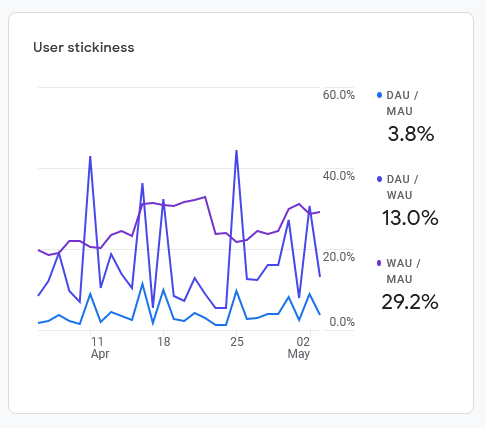Does WAU/MAU Matter for Your Ministry?

If you have upgraded to Google Analytics 4 (GA4) you may have noticed under the engagement section, a “Stickiness” report. This report is labeled with “DAU/MAU”, “DAU/WAU” and “WAU/MAU”. You’d be forgiven for overlooking this report, as these formulas look like gibberish to most of us, but hidden behind the acronyms is some data that you as a ministry leader might find interesting.
What do DAU, WAU, and MAU mean?
These acronyms stand for Daily, Weekly, and Monthly active users, respectively. They represent the number of active users that visit your website at least once per month, week or day. You may have heard these types of numbers reported by social media websites, like Facebook to demonstrate how engaged their users are, or tech startups often report these numbers when they are trying to raise capital and prove their ideas have merit. Until the launch of GA4, these numbers weren’t widely available as part of a free analytics package. So unless you’ve had a specific reason to seek them out, the odds are you’ve never given them a thought, but there may be value to ministry leaders to start keeping an eye on them now.
Why Would WAU/MAU Matter to Ministries?
Just like churches, digital ministries want to feed their website visitors beyond just one message on Sundays, your mission is to see your community grow and thrive every day of the year. This is why you do what you do, why you create content day in and day out. You may be like many ministries that offer a daily devotional, or audio program. If that is the case, looking at weekly daily and active users will allow you to see the impact of your content over time.
What You Can Do Next
This is intended primarily as food for thought, so the next step for most readers is simply to think about these metrics to see if they could be of value to your digital efforts. I do always like to offer practical action items, however, so here are two things you can do right now.
1. Upgrade to GA4 if you haven’t already. Google has stated they will be sunsetting older versions of Google Analytics so upgrading sooner rather than later will give you time to get used to the new interface.
2. Get your “stickiness” benchmarks, knowing how well you are currently doing at engaging your website visitors is the perfect starting point for making decisions.
Hopefully, this article will inspire you to think differently about the way you do digital ministry. Engagement is a critical part of any digital effort, but it often goes overlooked, because it’s hard to pin down with metrics, and it’s even harder to tie it to revenue or ministry impact. Maybe this is the first step in changing that.